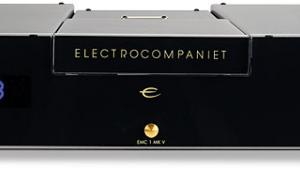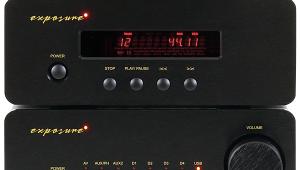Chord Electronics Red Reference (£13,345)
It amuses me immeasurably that there’s a flood of new high-end CD players when the format is under serious threat. Even that über-geek bible, Wired, recently ran a blog titled ‘Vinyl May Be Final Nail in CD’s Coffin’ – rich stuff coming from the most digitised read on earth. So, are audiophiles now being implored to buy our ‘final’ CD players?
In the face of MP3, high-def discs and other threats, there are still billions of CDs out there. And I can tell you right now that many of us will not be replacing our collections again. Frankly, I’m quite happy with the – what? fifth? – remastering of the Doors debut album. But if new players extract more from standard CDs, in the way upscaling DVD players enhance video off regular DVDs, can we ignore them?
Chord’s latest is an exercise in engineering overkill, purporting ‘to give the most accurate reproduction of compact disc that can be obtained’. Internal 176.4kHz upsampling data transfer, selectable RAM buffer clock retiming and other electronic solutions demonstrate that Chord has always preferred the scientific approach over the religious.
MONSTER PUNCH
A button-festooned monster of a machine, at 420 x 140 x 325mm (whd) and weighing a considerable 14kg, it oozes ‘Chord-ness’ – that over-engineered, Terminator-meets-Rolex look. It’s topped with the company’s cool conceit: an illuminated view of the innards. Uniqueness is assured by a CD mechanism slanted at 45º, an interesting take on disc loading that charms its way past slot or top-loading. A button operates a fluid-damped door that reminds me of the hatch in TV’s Lost.
Everything about the Red Reference is beautifully realised, machined and appointed, with features like the handles-cum-stacking-hardware that distinguish Chordware from everyone else’s. The front panel recesses contain joy-to-use ball-bearing push buttons for the main functions, next to a display showing CD status and input, buffer and frequency information. The buttons are so nice to operate that you’ll forgive Chord for supplying a hand-held remote that jars due to its plasticity. The rear, too, is well-appointed, with all connections via gold-plated phono or BNC coax, optical fibre or balanced XLR, suggesting a feel of studio gear. Empirically, it sure looks like thirteen grand plus.
Yes, you read that correctly. To be precise: £13,345. So it had better sound simply amazing. To attain heights of sonic ecstasy, Chord employs a Philips CD-Pro2 mechanism, reclocked with its data fed to the upsampling and filtering electronics. For some reason (and this applies to all who provide switchable filtering), the Red can select between 44.1, 88.2 or 176.4kHz sampling frequencies ... but why?! If ‘176’ is always the best setting, why would anyone want to use the lesser settings? Do any of you deliberately knobble your system’s ultimate capabilities?
BALANCED PLUG
Same, too, for connections. Unless your preamp lacks balanced inputs, always stick with balanced operation. This isn’t subtle, and I’ll argue with anyone who still insists that balanced operation only addresses cable length. If you can’t hear the difference between
single-ended and balanced, especially with this machine, then go buy something for £29 from Aldi.
Thus I stuck to the XLR output/176.4kHz setting, feeding the Chord via Yter XLR cables to the McIntosh C2200 preamp, MC2102 and Quad II-eighty power amps; speakers included Sonus faber Cremona M and Guarneri, and Tannoy Mini Classics. And the initial session, having left the unit switched on for 24 hours ‘just in case’, was, er, interesting. Especially coming fresh from the Nagra CDP.
My relationship with Chord equipment is simple: primarily, I love the Choral range as much for its style as its performance. I realise that such an attitude is, to many of you, akin to child molestation. But, unlike many of you, I live in the real world, where consumers also value qualities like price, quality, reliability, ergonomics... and styling. (Still I resist the reductio ad absurdum of B&O, while understanding its appeal.)
Equally, I respect rather than love Chord’s heavier guns, finding the build and functionality to set new standards for this entire industry. Yet the sound strikes me as a bit, well, analytical or even cold. This, however, is not a condemnation; rather, it’s a statement of personal preference. To put it another way, Chord’s ‘sound’ is as far removed from the valves I value over everything else, as it is possible to be.
RAUNCH OF THE RINGS
Take, for example, the most absurd recording one could ever use to assess a high-end system: Blue Cheer’s version of ‘Summertime Blues’ – probably the world’s first thrash track. Simply put, meters barely move when this is playing. The effect should be a Spectorian wall of sound, raunchy, roiling, grinding noise that could have accompanied the orc army marching, had Quentin Tarantino rather than Peter Jackson directed Lord of the Rings. Somehow, Chord manages to clean it up, dissect it, separate the instruments.
Which isn’t quite what the band had in mind. Its sheer mass, the weight of the bass, the wholeness of the juggernaut assault is the song’s raison d’etre. It should overwhelm the listener. Increase the level, and the presentation remains consistent – a virtue, yes, but where’s the beef?
Turning to more varied material, such as Johnny Rivers’ live Last Boogie In Paris, revealed undeniable strengths, not least being openness and transparency. It’s here that Chord’s hygiene becomes a virtue, every nuance and every detail rewarding the listener with an unobstructed view of the proceedings. Each instrument had authentic scale and positioning, stage recreation was near-perfect, with the impact of the percussion – no less than the legendary Jim Gordon – especially noteworthy... and in direct contrast to the handling of the Blue Cheer track.
Voices, too, could vary, the Chord preserving the crystalline beauty of country warblers like Emmylou Harris and Alison Krauss, though the textures of some male vocals seemed diminished. Likely to be one of this year’s hottest demo discs, and a perfect source for such a comparison, is Krauss’ duet with Led Zep’s Robert Plant, which demonstrates this bipolarity with inescapable clarity.
VERDICT
But is the Chord Red Reference a great player? Its flaws are tolerable, so I offer a qualified ‘yes’. Is it worth £13,000? At this stage in my life, I fail to see how any CD player is worth that sort of money, so I have to say: only if you are simpatico with the Chord ethos and adore the unit’s sheer presence, which is mighty. Me? I’m sticking with my Marantz CD-12, for another 20 years.
Originally published in the January 2008 issue

























































